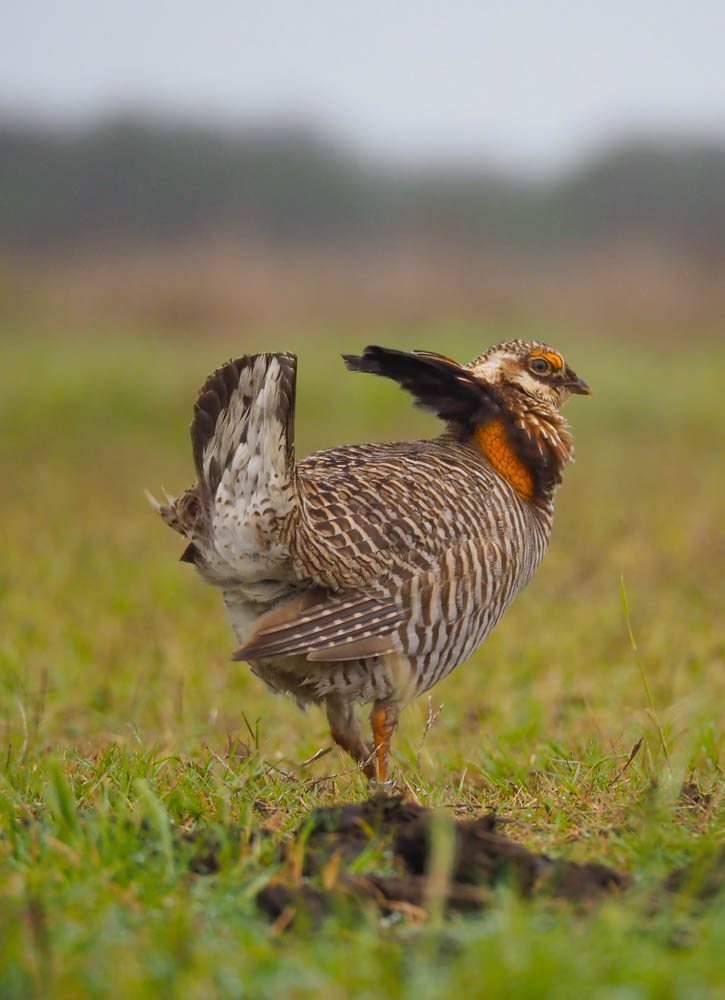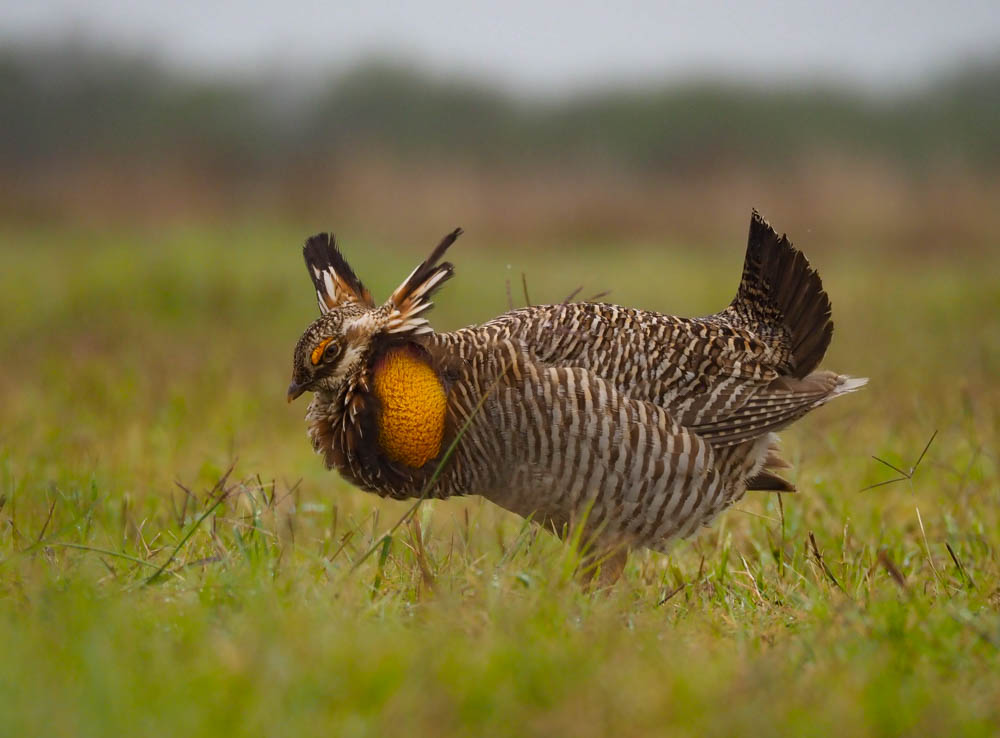
The Attwater prairie chicken attracts hens with dancing and a “booming” call. Photo by Pam LeBlanc
In a grassy field near Goliad dotted with cow patties, eight football-size birds waggle their tails, inflate mango-colored pouches on their necks, stamp their feet, and emit a forlorn “woo-woo-woo.”
Attwater Prairie Chicken National Wildlife Refuge Visitors Center
Address:
1206 APC NWR Road, Eagle Lake
Hours: Mon.-Fri.,
7:30 a.m.-4 p.m.
Admission: Free
Website:
fws.gov/refuge/
attwater-prairie-chicken
These male Attwater prairie chickens (also spelled as Attwater’s prairie chicken) hope their flashy “booming” display will impress the hens. Experts working to protect the critically endangered species hope the chickens get lucky, too.
Fewer than 200 exist in the wild, in two isolated colonies in Texas—the Attwater Prairie Chicken National Wildlife Refuge in Colorado County, and on this parcel of privately owned ranch land that is part of the Nature Conservancy’s Refugio-Goliad Prairie Project.
So far this year, researchers have counted 51 males at the Goliad site and estimate 50 females are lurking nearby. With another month to go in booming season, when the males’ perform their mating dance and researchers can more easily see and count the birds, they expect to find more.
That’s good news for Kirk Feuerbacher, the working lands project director at The Nature Conservancy. Feuerbacher, along with representatives from the U.S. Fish and Wildlife Service and other agencies, works with landowners in the area to preserve the habitat these flashy and endearing birds need to survive.
It hasn’t been easy.
Attwater prairie chickens, a type of grouse, were so numerous in the 1800s that cowboys working cattle on the range hunted them for food. Since then, urbanization, agricultural needs, encroaching brush, and the proliferation of imported red fire ants have contributed to the loss of the birds’ habitat. Less than 1% of the coastal prairie that once stretched from South Texas to the Louisiana coast remains.
“The reality of it is prairie is disappearing all over the world,” Feuerbacher says as he watches the chickens strut, cackle, and spin in the grass on a misty morning in March. “The prairie chicken is the canary in the coal mine. Its needs are so specific that (when the population struggles) it indicates that its habitat is degraded.”
The dancing birds, all but oblivious to their human admirers, continue to call out, spin, and fluff their feathers, but no females appear. After about 30 minutes, Feuerbacher leaves them to their performance.
The birds were first listed as a federally protected endangered species in 1967. Their population has ebbed and flowed over the years. A captive breeding program began in the early 1990s, but by the end of the decade, the Attwater prairie chickens were nearly wiped out in the wild.

The mango-colored pouch of an Attwater prairie chicken inflates during the mating dance. Photo by Pam LeBlanc.
Then biologists realized that imported red fire ants were competing for the insects the chicks eat during the first few weeks of their lives. They began treating areas where the chickens boomed to control the ants. They also used prescribed fires to remove brush, where predators that eat the chickens hide, and encouraged ranchers to rotate their cattle onto different fields to keep the prairie healthy. And in 2007, biologists began regular releases of chicks into the wild, to supplement existing populations.
The chickens’ dire situation improved until 2017, when Hurricane Harvey swept along the Texas coast, flooding the birds’ nests, which are laid on the ground. The number of wild Attwaters prairie chickens plummeted to fewer than 20.
But these chickens are resilient, and in 2021 their numbers climbed again, to a near 30-year high of an estimated 178 individuals in the wild. So far this year’s count looks promising. Besides the roughly 100 birds already estimated on the Goliad land, and a separate cluster of birds that Feuerbacher has heard out there but not yet spotted, an additional 20 or so wild birds live at the natural refuge in Colorado County.
“It looked really bad for a while but now it’s looking up,” he says.
Attwater prairie chicken hens typically lay between 8 and 13 eggs in May. Many will succumb to predators that include owls, raccoons, hawks, snakes, and coyotes. But researchers supplement the number of those that survive with captive-bred birds that are placed in pens at the site and then released after they’re a few weeks old. About 30% usually survive to adulthood.
With a little luck, those birds will still be here for next year’s booming season.
One thing that is certain? Protecting habitat is critical to the species’ survival.
“The prognosis is recovery is possible, but difficult,” says Tim Anderson, a biologist with U.S. Fish and Wildlife Department who also works on the Refugio-Goliad Prairie Project. “And impossible without private landowners,” Feuerbacher adds.
In the meantime, the Attwater prairie chickens will keep two-stepping through the coastal prairies of Texas in hopes of attracting a mate through April.








